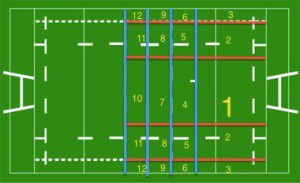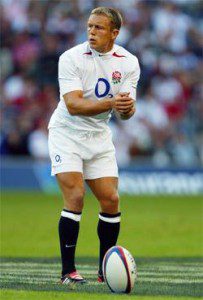

PHILADELPHIA, PA – Since it was pointed out the folly of Lawrence Dallaglio’s commentary during a Bath game this winter, I have been periodically tracking kicks. His point: George Ford needs to improve his goal kicking if he wants to be the England 10. The point was good; the justification poor.
Here is an Update on the Quest for Better Rugby Kicking Stats; specifically the goal kicking stat. Before we start explaining the data, let me acknowledge that there is data being housed out there, but, so far, we haven’t been able to access it. The result is that I am getting my own data to test my idea about evaluating goal kickers.
My collection of data has been pretty unscientific. I track kicks during games I want to watch, but not ones I want to watch so badly that collecting data takes away from the fun of being a fan.
The idea is that rugby goal kickers should be evaluated by a stat that is better than simple percentage. To do that, I divided the field into 12 zones. For each kick, I noted whether it was a penalty or conversion, from which zone it was taken, and whether it was made or missed. A super-spiffy version of the segmented field is here:

With the Zone Data, it is then possible to see whose kicking adds the most value to his team. Making a kick from Zone 1 adds no value. Making a kick from Zone 11 (Hello, Delon Armitage!) adds significant value. Because there is not yet the data to get into individual performances, I will leave the details of weighting the different zones for a different day.
I have tracked kicks for quite a few, but not all, Heineken Cup games this year and a bunch of English Aviva Premiership games and just a few from RabboDirect Pro12. Because I am a Bath supporter, I have more Bath kicks tracked than any other club. This is not great news for George Ford. So far, I have charted close to 200 kicks. Because of the relatively small sample size for any given individual, I don’t think any meaningful conclusions can be reached yet for which kickers, of those tracked so far, are adding the most value.
Back to Mr. Dallaglio. Friday night, Bath played Northampton at The Rec. During the game, Stephen Myler missed a kick from Zone 2. Dallaglio said that Myler would be disappointed with missing that kick because of his high standards. We know Myler was disappointed, but how bad was the miss?

To the spreadsheet! Of the 64 kicks taken from Zone 2 tracked so far, 64% have been made. For comparison, 98% of kicks taken from Zone 1 were made and 59% from Zone 3.
Yes, Myler should have made the kick. At first glance, it doesn’t look like the miss was that bad. 46% of kicks from Zone 2 are missed, after all. However, most of the misses from Zone 2 were conversions–kicks the team did not elect to take. 83% of penalties taken from Zone 2 were made. This makes Myler’s miss seem worse since when the captain elects to take a penalty from Zone 2, the expectation is much higher for success.
This also helps to illustrate a significant flaw in the system I have been using so far: another stripe of the field is needed. Zone 2 includes all kicks 6 meters in to 20 meters in. Not all of those kicks are really the same level of difficulty, obviously. The reason I started with the zone that way is because it is easy to know whether a kick is between 5 and 15 meters from touch and pretty easy to eyeball the extra 5 meters past the 15 meter markings on the field. Most of the missed conversions in Zone 2, I suspect, are closer to 6 meters from touch as opposed to 19 meters from touch, but I don’t have the data to check.
With the data we do have, Myler’s miss was pretty darn bad–by anyone’s standards. Dallaglio’s comment is true, but careful use of data allows us all to understand the situation more fully.
Dallaglio already knew that George Ford needed to improve his place kicking. Do we need a spreadsheet and nerds in order to understand this? The collection and use of data allows us to better understand the things we already kinda get. It also allows for new insights and old biases to be exposed.
One question, I really want to answer is how much of the difference between Worcester (bottom of the table and facing relegation) and Gloucester (middle of the table) this season stems from goal kicking. Another question is whether or not Zach Pangelinan should be playing fly-half for the USA Eagles. A big part of answering that question must be about how much value he adds through his goal kicking. Game tape, or varying quality, is out there from his season with OMBAC. Careful review of his performance from the tee seems essential. In an email I sent to Mike Tolkin–sent only as a curious fan–he indicated the Eagles staff is not yet evaluating goal kickers in a strictly quantitative manner. As a fan who wants to see the Eagles preparing wisely for the Rugby World Cup, this adds to the wrinkles on my forehead.

On the television broadcast, the commentators will chat away after a penalty is given, sometimes while a replay is running or they are showing a shot of the coach or an injured player or whatever. If you care about kicks–and they are worth real points, so we should all care–you sit waiting for the confirmation that the team has selected to take a shot at the posts and who will take the kick and from whence the kick will be taken. It is true that I don’t need to see the whole of, say, Nick Evans’ routine as he gets ready to kick. The decision, though, to attempt the kick, the spot of the penalty, and the kicker are all things that matter. They matter a lot in some circumstances, like the Bath v Northampton game which ended in a draw.
In addition to goal kicking, what else can we track better? I have ideas for ways to evaluate kicks from hand and will try to start working on that soon. It seems that we ought to be tracking the outcome of decisions made to take the scrum or “kick for the corner” from a penalty and take the line out.
I will continue to work to better understand the game we love and share whatever I learn along the way, and I am happy to hear of and from others in the same pursuit.
That’s it for now. Feel free to comment below, please look for and “Like” our Facebook Rugby Wrap Up Page and follow us on Twitter@:RugbyWrapUp, Junoir Blaber, Nick Hall, James Harrington, Jamie Wall, Jaime Loyd, DJ Eberle, Cody Kuxmann, Karen Ritter, Jake Frechette and Declan Yeats, respectively.

